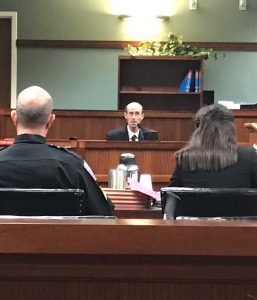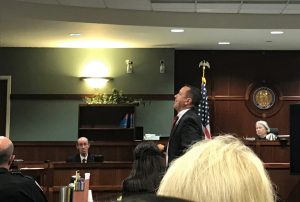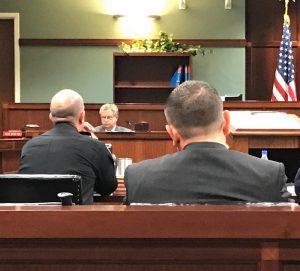By Mark Hansel
NKyTribune managing editor
Daniel Greis took the stand in his own defense Friday to explain, in his own words, the events that led up to a two-car crash that killed a family of five in Southern Kenton County in October.

Daniel Greis took the stand in his own defense Friday. He is charged with five count of wanton murder as a result of a crash he was involved in, in October, that killed five members of the Pollitt family (photos by Mark Hansel).
Greis, 58, said he feels responsible for the deaths of the family, but added that the motorist he was attempting to pass at the time of the crash shares the blame.
“I feel responsibility, yes. Those people died horribly. It was my car that hit them,” Greis said. “I didn’t see it but I hit that car. They didn’t have a chance. I was praying, ‘please God, don’t let there be anyone over the hill.’”
He is charged with five counts of wanton murder.
Greis was traveling on the wrong side Staffordsburg Road on October 26, when he struck a Honda Accord driven by Rodney Pollitt, Jr. head-on. Pollitt, 26, his fiancé, Samantha Malohn, 27, and their three children, Halieann, 9, Brenden, 8, and Callie Pollitt, 6, were all pronounced dead at the scene.
Greis said Jesse Phillips, a driver he was attempting to pass, kept his Dodge pickup truck alongside Greis’s Honda Pilot SUV as the two approached a rise in the road. He said Phillips would not allow him to pass, or get back behind him into the proper lane.
Phillips has not been charged in the case.
Greis was estimated to be traveling 86 miles per hour and investigators say his wheels left the ground as he crested the rise and hit the Pollitt vehicle. He had a blood-alcohol content of .089 and he had marijuana in his system.
Greis, who works third shift at a Kroger store, recounted the events leading up to the crash that October day, saying he got home from work at about 6:30 a.m. He admitted to taking about four “hits” of marijuana to deal with chronic back pain, but said he wasn’t “high” and did not smoke any more that day.
“If I was high, I wouldn’t have drove,” he said.

Kenton Commonwealth’s Attorney Rob Sanders, right, challenged Daniel Greis’s claim that his only option was to speed up as he approached a blind rise on the wrong side of Staffordsburg Road in October. Greis hit a vehicle coming in the opposite direction, killing five members of the Pollitt family.
Greis did acknowledge that 3.6 grams of marijuana found near him at the crash site was his, but said he inadvertently put it in a jacket he wore that day. He said he didn’t remember he had the marijuana on him until he felt it in his pocket when he was at a golf course later that day.
Greis said that morning he drank a partially filled bottle that contained bourbon and Coke, left over from the previous day. He said he usually makes a mixed drink of bourbon and Coke in a 17-ounce bottle in the morning and drinks it throughout the day, but did not on the day of the crash.
Greis went to Tire Discounters that morning to get the brakes checked on the Honda Pilot, then called a friend, Bruce Grainger, and met up with him to play a round of golf.
Halfway through the 18-hole round, which began around noon, Greis stopped at the clubhouse and purchased a double-shot of Maker’s Mark bourbon, with ice, which he said he drank while playing the back nine.
Greis drove Grainger home after the round.
Grainger had testified earlier that, concerned because Greis had hardly slept that day, he asked his friend if he was alright to drive home.
Greis assured him that he was and testified Friday that he did not feel impaired by the alcohol, marijuana, or lack of sleep.
Greis said he then started on the route back to his home.

Defense witness Neil Gilreath waits on the witness stand as attorneys return from one of several conferences at Judge Patricia Summe’s bench Friday. Gilreath showed a simulation depicting the events leading up to a crash that killed five people, based on an account from defendant Daniel Greis and other evidence.
Faith Williams testified Thursday that Greis passed her and another car at a high rate of speed in a no-passing zone that day, prior to the crash, but Greis denied that on the stand Friday.
He acknowledged passing another slow-moving vehicle before coming upon Phillips in the pickup truck.
Greis said Phillips was traveling slowly, so he moved over slightly in the road to see if it was safe to pass, but a car was coming in the opposite direction, so he pulled back in line.
He then attempted to pass Phillips again, he said, just as he approached a no-passing zone. He said Phillips kept slowing down and speeding up, keeping him trapped in the lane designated for traffic coming in the opposite direction.
Recognizing that he was coming to a blind rise in the road about 625 feet ahead, Greis said knew he had to get back in the proper lane, so he sped up.
A device used to measure speed, braking and other information inside the Honda Pilot confirms Greis was traveling between 82 and 86 miles per hour in the five seconds before the crash and did not hit the brakes in the last three seconds.
“There was never a point where I could get over behind him, so I tried to get ahead of him,” Greis said. “I thought speeding up was my only hope of getting over.”
Greis said he doesn’t remember what happened in those final few seconds and witnesses told him as he was laying on the side of the road with the Honda Pilot on its hood that he had hit another car.

Defense expert witness Harry Plotnick (center) said there was not enough evidence to determine defendant Daniel Greis was impaired when he crashed into a car while driving on the wrong side of the road, in a crash that killed five people.
In videos from a body cam worn by an officer who interviewed Greis in the hospital, the defendant did not recall the moments leading up to the accident, or the interaction with Phillips.
On the stand Friday, he attributed that to the severity of his injuries from the accident and pain medication he was taking at that time.
On cross-examination, Kenton Commonwealth’s Attorney Rob Sanders asked Greis why he didn’t just stop, if he knew he was coming to a blind rise where a vehicle might be approaching.
“If you had time to pray, isn’t it true that you had time to stop?” Sanders asked. “So the time it took to perceive the possible deadly consequences, think of God’s name, to pray to God that there be nobody coming in the other direction, that’s less time than it took to put your foot on the brake.”
Greis said he panicked and was concerned that if he tried to stop too quickly at such a high rate of speed he might lose control of the vehicle.
Defense witness Neil Gilreath of Focus Investigations played a video simulation for the jury that he said reenacted Greis’s account of the seconds before the accident.
There were several objections to questioning, and attorney discussions at the bench of Circuit Jude Patricia Summe, before the simulation was shown.
Gilreath said, based on that simulation, if Phillips had maintained a speed of 55 miles per hour, or even 65 miles per hour, Greis would have had time to pass before reaching the blind rise.
Sanders says impairment from the combination of alcohol, marijuana and lack of sleep were the cause of the accident and a forenic pathologist called Thursday supports that assertion.
Dr. Gregory Davis said that while visible symptoms vary from one person to another, the impact of alcohol and marijuana circulating in the blood will always have an effect on the central nervous system. He also said that because the blood was not drawn immediately after the accident, Greis’s blood-alcohol content was at least .10 at the time of the crash.
Harry Plotnick, a defense expert witness called Friday, did not dispute that claim, but said there was not enough evidence to determine if the combination of factors resulted in impairment.
On cross examination, however, Assistant Commonwealth’s Attorney Maria Schletker introduced a case from 17 years ago where Plotnick indicated the factors identified by Sanders were enough to cause impairment.
Plotnick said he didn’t immediately recall the case, but acknowledged he signed off on the statement. He said there could have been other factors, not identified in court Friday, that helped him reach that conclusion in that case.
When the trial resumes Tuesday, Sanders is expected to cross-examine Grainger and call rebuttal witness, which will be followed by closing arguments.
The case is being heard in Judge Summe’s Kenton County courtroom and it could go to the jury by midweek.
Contact Mark Hansel at mark.hansel@nkytrib.com



















